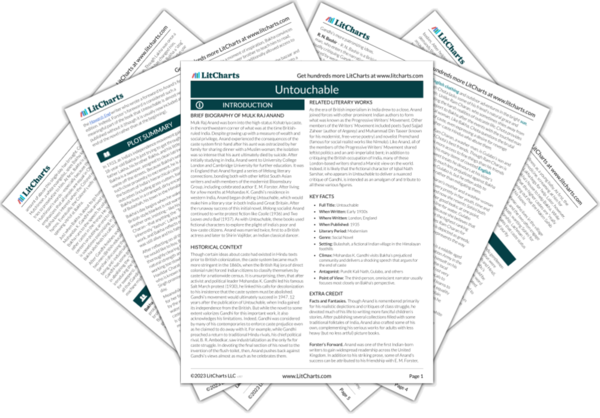Brief Biography of Mulk Raj Anand
Mulk Raj Anand was born into the high-status Kshatriya caste, in the northwestern corner of what was at the time British-ruled India. Despite growing up with a measure of wealth and social privilege, Anand experienced the consequences of the caste system first-hand after his aunt was ostracized by her family for sharing dinner with a Muslim woman; the isolation was so intense that his aunt ultimately died by suicide. After initially studying in India, Anand went to University College London and Cambridge University for further education. It was in England that Anand forged a series of lifelong literary connections, bonding both with other leftist South Asian writers and with members of the modernist Bloomsbury Group, including celebrated author E. M. Forster. After living for a few months at Mohandas K. Gandhi’s residence in western India, Anand began drafting Untouchable, which would make him a literary star in both India and Great Britain. After the runaway success of this initial novel, lifelong socialist Anand continued to write protest fiction like Coolie (1936) and Two Leaves and a Bud (1937). As with Untouchable, these books used fictional characters to explore the plight of India’s poor and low-caste citizens. Anand was married twice, first to a British actress and later to Shirin Vajifdar, an Indian classical dancer.
Historical Context of Untouchable
Though certain ideas about caste had existed in Hindu texts prior to British colonization, the caste system became much more stringent in the 1860s, when the British Raj (era of direct colonial rule) forced Indian citizens to classify themselves by caste for a nationwide census. It is unsurprising, then, that after activist and political leader Mohandas K. Gandhi led his famous Salt March protest (1930), he linked his calls for decolonization to his insistence that the caste system must be abolished. Gandhi’s movement would ultimately succeed in 1947, 12 years after the publication of Untouchable, when India gained its independence from the British. But while the novel to some extent valorizes Gandhi for this important work, it also acknowledges his limitations. Indeed, Gandhi was considered by many of his contemporaries to enforce caste prejudice even as he claimed to do away with it. For example, while Gandhi preached a return to traditional Hindu rivals, his chief political rival, B. R. Ambedkar, saw industrialization as the only fix for caste struggle. In devoting the final section of his novel to the invention of the flush-toilet, then, Anand pushes back against Gandhi’s views almost as much as he celebrates them.
Other Books Related to Untouchable
As the era of British imperialism in India drew to a close, Anand joined forces with other prominent Indian authors to form what was known as the Progressive Writers’ Movement. Other members of the Writers’ Movement included poets Syed Sajjad Zaheer (author of Angarey) and Muhammad Din Taseer (known for his modernist, free-verse poetry) and novelist Premchand (famous for social realist works like Nirmala). Like Anand, all of the members of the Progressive Writers’ Movement shared leftist politics and an anti-imperialist bent; in addition to critiquing the British occupation of India, many of these London-based writers shared a Marxist view on the world. Indeed, it is likely that the fictional character of Iqbal Nath Sarshar, who appears in Untouchable to deliver a nuanced critique of Gandhi, is intended as an amalgam of and tribute to all these various figures.
Key Facts about Untouchable
-
Full Title: Untouchable
-
When Written: Early 1930s
-
Where Written: London, England
-
When Published: 1935
-
Literary Period: Modernism
-
Genre: Social Novel
-
Setting: Bulashah, a fictional Indian village in the Himalayan foothills
-
Climax: Mohandas K. Gandhi visits Bakha’s prejudiced community and delivers a shocking speech that argues for the end of caste
-
Antagonist: Pundit Kali Nath, Gulabo, and others
-
Point of View: The third-person, omniscient narrator usually focuses most closely on Bakha’s perspective.
Extra Credit for Untouchable








